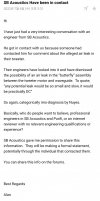@Nuyes Could you please share what is your go to method to detect air leaks?
1.Binding Post
On the day sample B arrived and the stereo set was completed, my friend visited my studio.
He listened to "Limit your love - James Blake" because he is a low-pitched audio enthusiast, and immediately detected a strange noise.
After listening to his attention, I also listened to the same song, and I could hear strange noises like farts.
We looked around the speakers with the music playing, and we could use our ears to find the problem right away.
The binding post was howling when the bass guitar player was playing, and when the kick drum was playing.
And it was solved by shilling.
2. Rubber insert nut
After repairing the binding post, I pushed the passive radiator to make sure it was sealed well.
Woofer was pushed out, but soon returned to his place.
This was evidence that additional leaks were occurring.
I don't know if it's clear that the rubber insert nut is leaking.
However, it was pulled out when pushed with force.
It wasn't hard enough.
Therefore, I sealed a total of 24 insert nuts per speaker and confirmed that additional leaks were reduced in the same test.
3.Twitter Assembly
I can't check if this is a leak of air.
However, one thing I can be sure of is that significant differences in sealing were observed in the same comparative environment without any changes in the internal sound absorbers (using Klippel and Earthworks).
This may not have been a leak of air, but an additional tremor caused by internal resonance.
And it's improved.


